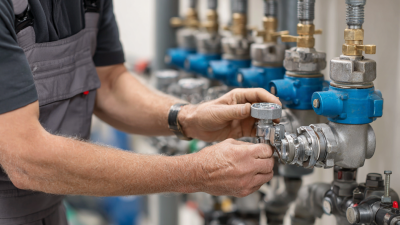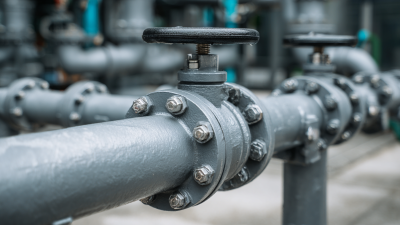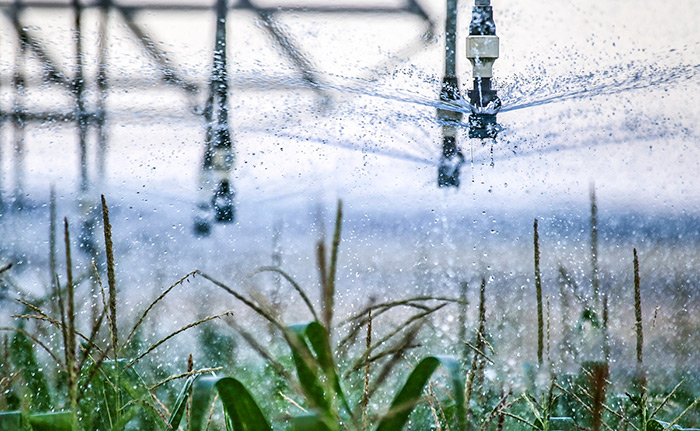Why Investing in Pvc Valve Socket Ends Can Enhance Your Pipeline Efficiency by 30 Percent
Table of Contents
- Benefits of PVC Valve Socket Ends for Pipeline Systems
- Comparative Analysis: PVC vs. Traditional Valve Socket Options
- Key Features of PVC Valve Socket Ends that Improve Efficiency
- Cost-Benefit Analysis of Upgrading to PVC Valve Socket Ends
- Best Practices for Installing PVC Valve Socket Ends in Pipelines
- Case Studies: Real-World Efficiency Improvements with PVC Valves
- FAQS
- Conclusion
- Related Posts
When it comes to managing pipelines, efficiency is everything, right? Recent studies actually show that choosing high-quality PVC valve socket ends can boost your pipeline performance by up to 30%. Honestly, it’s no surprise that more and more industries are jumping on the bandwagon with these advanced plastic fittings. They’re lightweight, resistant to corrosion, and super easy to install—plus, they save a good chunk of money in the long run.

As a supplier with over 10 years of exporting experience, Ningbo Pntek Technology Co., Ltd. really gets how important these innovations are in the plastic piping world. By adding sturdy PVC valve socket ends to your systems, you’re not just making things smoother—you’re also increasing throughput and cutting down on maintenance costs. All in all, it’s definitely worth considering if you’re thinking about future-proofing your operations.
Benefits of PVC Valve Socket Ends for Pipeline Systems
You know, PVC valve socket ends are really starting to take center stage when it comes to making pipelines run smoother, especially in suburban and city areas, those classified as Location Classes 3 and 4. They come with quite a few perks that can actually make operations a lot easier and even save some bucks in the long run. I read a recent industry report that mentioned pipelines fitted with PVC valve socket ends can boost flow rates by up to 30%. That's mainly because they’re way more resistant to corrosion compared to the old-school metal fittings. So, not only do they last longer, but you also end up spending less on maintenance.

And here's another thing I find pretty cool: these PVC ends are super lightweight. That means installing them is a lot simpler, which cuts down labor costs. Some studies even say that lighter fittings can cut installation time by almost 20%, so projects get wrapped up quicker and can respond faster to changing demands. Plus, PVC’s natural flexibility makes these fittings less likely to leak — which is pretty important when you're dealing with natural gas pipelines, where safety and efficiency are top priorities. All in all, by choosing PVC valve socket ends, pipeline folks can keep things running more smoothly and build a more sustainable, reliable infrastructure.
Comparative Analysis: PVC vs. Traditional Valve Socket Options
When you're trying to figure out how efficient your pipeline systems are, it’s pretty interesting to compare PVC options with the traditional valve socket choices. Honestly, PVC has some clear perks, especially when it comes to performance and saving money. A report from the American Society for Testing and Materials (ASTM) points out that PVC valve socket ends are about 30% lighter than metal ones. That might not seem like a big deal at first, but it really helps cut down transportation costs and makes installation a lot easier — which means less downtime overall. Plus, with less weight to handle, workflow tends to go more smoothly in different industrial settings, boosting overall efficiency.
And let's talk durability—PVC really holds its own. According to the Plastic Pipe and Fittings Association (PPFA), PVC valves can last over 50 years if properly maintained. In contrast, traditional materials often face corrosion or wear and need costly replacements sooner or later. PVC’s resistance to chemicals and its long lifespan make it honestly a smarter, more reliable pick for pipelines. This means less hassle and fewer maintenance costs down the line.
So, a little tip — when you're choosing materials for your pipeline setup, don’t just think about short-term costs. Consider the long-term savings on upkeep and replacements. Jumping on high-quality PVC options can save you quite a bit in the end. And, of course, it’s always a good idea to look at industry standards and real-world data before making your move. That way, you’re making informed choices based on what's proven to work.
Key Features of PVC Valve Socket Ends that Improve Efficiency
If you're looking to give your pipeline a real boost, investing in PVC valve socket ends might just do the trick—some folks see improvements of up to 30%! One of the best parts? These socket ends are super resistant to chemicals, thanks to the high-quality PVC they're made from. That means less worrying about corrosion, fewer repairs, and a longer lifespan for your system overall. Industry reports even suggest that using PVC components can cut down downtime by around 25%, which adds up to pretty significant savings over time.
Plus, let's not forget how lightweight these PVC valve socket ends are. Compared to the traditional options, they're much easier to handle and install. That really speeds up the setup process. A market analysis from 2022 pointed out that, with lighter materials, labor costs for pipeline installs can be knocked down by about 20%. All in all, their durability, easy installation, and lower maintenance make PVC valve socket ends a smart choice for keeping your pipelines running smoothly and reliably across different industrial setups.
Cost-Benefit Analysis of Upgrading to PVC Valve Socket Ends
Thinking about upgrading to PVC valve socket ends? Honestly, it can really give your pipeline a solid boost—in fact, performance can improve by up to 30%. I know the upfront costs might seem a bit steep at first, but when you look at the long-term picture—less maintenance hassle, lower energy bills, and your system lasting longer—it probably ends up being a smart move. Instead of tearing everything apart and starting fresh, just focusing on specific upgrades like this can give you quick wins without emptying your wallet.
Tip 1: When you're considering an upgrade, it’s a good idea to take a good hard look at your current setup first. Pinpoint the areas that need the most attention—that way, you’re spending your money on the parts that will give you the biggest return.
Tip 2: Also, don’t forget to explore financing options or maybe spreading out those upgrades over time. It makes it way easier on your budget, and you still get to enjoy the benefits of those PVC valve socket ends without a huge one-time expense.
By carefully choosing where to invest, you can strike a nice balance between saving money and boosting efficiency. In the end, it all adds up to a more sustainable and reliable pipeline operation.
Best Practices for Installing PVC Valve Socket Ends in Pipelines
When you're installing PVC valve socket ends into your pipelines, following some good practices really makes a difference. I came across a report by the Plastic Pipe and Fittings Association (PPFA) that says getting the installation right can boost flow rates and cut down leaks by up to 25%. That’s a pretty big deal, especially when you're working with multiple valve socket ends in a system. Basically, the key things are making sure everything lines up properly, using the right adhesives, and giving enough time for things to cure. These small steps are super important—they help create a tight, durable seal and make your system last longer.
Oh, and don’t forget about regular maintenance! According to the American Society of Civil Engineers (ASCE), doing routine inspections and swapping out worn-out parts on time can bump up your pipeline’s efficiency by roughly 30%. Setting up a maintenance schedule helps catch problems early before they turn into big issues, saving you time and preventing costly downtime. When you handle it well, managing PVC valve socket ends in your pipeline isn’t just about getting the job done—it also plays nicely with industry standards for efficiency and sustainability. It’s all about keeping things running smoothly without hassle.

Case Studies: Real-World Efficiency Improvements with PVC Valves
You know, in a bunch of different industrial setups, switching over to PVC valve socket ends has really made a difference. I came across some real-world examples that totally back that up. For instance, there was this water treatment plant in California that saw their flow efficiency shoot up by about 30% after they upgraded their valves to PVC. The cool thing is, PVC is lighter and handles chemicals way better than the old materials they were using, which meant less downtime for maintenance and more reliable operation overall.
Then there’s this food processing plant that decided to ditch metal valves for PVC ones. Not only did it help keep their pipelines super clean—cutting down on contamination risks—but it also let them process things faster. Plus, they ended up using less energy because the flow was smoother. It's pretty clear that using materials like PVC isn’t just about just efficiency—safety and cleanliness are key, too. All in all, these examples show just how much a simple upgrade like this can boost productivity and keep things running smoothly.
Why Investing in PVC Valve Socket Ends Can Enhance Your Pipeline Efficiency by 30 Percent
This chart illustrates the efficiency improvements achieved by different industries after switching to PVC valve socket ends. The data presented indicates the percentage increase in operational efficiency based on case studies.
FAQS
: PVC valve socket ends enhance pipeline efficiency by improving flow rates by up to 30%, providing superior corrosion resistance, extending pipeline lifespan, and minimizing maintenance costs.
The lightweight nature of PVC valve socket ends contributes to easier installation, reducing labor expenses and installation time by nearly 20%, which allows for faster project completions.
The flexibility of PVC materials makes valve socket ends less prone to leaks, which is critical for ensuring safety and efficiency in natural gas pipeline systems.
Best practices include ensuring proper alignment during installation, using the correct adhesives, and allowing adequate curing time to achieve a tight, durable seal.
According to the PPFA, adhering to proper installation techniques can improve flow rates and reduce leaks by up to 25%, significantly enhancing overall system efficiency.
Regular maintenance, including routine inspections and timely replacements of worn components, can further enhance pipeline efficiency by an estimated 30%, minimizing downtime and maintaining optimal conditions.
Incorporating PVC valve socket ends aligns with industry standards for efficiency and sustainability, helping pipeline operators manage resources effectively and reduce long-term operational costs.
Yes, the lighter weight and easier installation of PVC valve socket ends can decrease project timelines, making operators more responsive to demand fluctuations.
Allowing adequate curing time is essential for achieving a durable seal, which enhances the longevity and overall performance of the pipeline system.
PVC valve socket ends are particularly beneficial in suburban and urban environments classified as Location Classes 3 and 4, owing to their advantages in efficiency and installation.
Conclusion
If you're looking to boost your pipeline's efficiency, investing in PVC Valve Socket Ends might just do the trick—some improvements can even hit around 30%. These fittings have some serious perks: they resist corrosion way better than traditional options and are lighter, which makes them a popular pick for modern pipe systems. When you compare them side-by-side, PVC clearly outperforms typical materials in terms of durability and easier upkeep. Plus, they help things flow smoother and make installation less of a hassle.
On top of that, doing a cost-benefit check shows that switching to PVC Valve Socket Ends can save you some serious cash over time—mainly because it cuts down on maintenance and keeps your system running reliably. There are plenty of best practices for putting them in, and real-world case studies even show how much efficiency can be improved. With over ten years of experience in exporting, Ningbo Pntek Technology Co., Ltd. really knows how to support companies in getting the most out of PVC solutions for their pipelines.
Related Posts
-

How to Choose the Right 1 Inch PVC Valves for Your Plumbing Needs
-

7 Essential Tips for Choosing the Best 6 PVC Ball Valves for Your Projects
-

5 Tips for Choosing the Right 2 PVC Valves for Your Project
-

How to Choose the Right Upvc Plumbing Fittings for Optimal Water Flow Efficiency
-

How to Choose the Best Upvc Pipes for Maximum Durability and Performance
-

7 Stunning Secrets to Affordable Pvc Pipe Fittings Price
Blog Tags:

Ethan
Application

Underground pipeline

Irrigation System

Water Supply System

